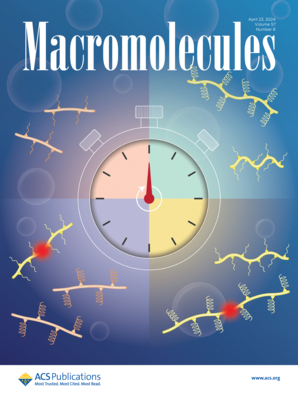Polynorbornenes Bearing Cyclic Fluoroalkyl Side Groups for Achieving High Glass Transition Temperature and Low Refractive Index
IF 5.1
1区 化学
Q1 POLYMER SCIENCE
引用次数: 0
Abstract
Partially fluorinated polymers exhibit various properties owing to their fluoroalkyl groups: thus, understanding the types of fluoroalkyl groups incorporated into a polymer chain is crucial for controlling the physical properties and is of significant academic interest. Although polymer backbone structures frequently incorporate short linear fluoroalkyl groups, cyclic fluoroalkyl groups are comparatively rare. To achieve both a high glass transition temperature (Tg) and low refractive index (n), polynorbornenes with several types of cyclic fluoroalkyl side groups are synthesized by ring-opening metathesis polymerization. Most of the synthesized polymers could form thin films via spin coating from nonfluorinated organic solutions. The films were transparent to the ultraviolet and near-infrared wavelengths region. The Tg and n of partially fluorinated polynorbornenes depend on the steric bulk of the side groups. Furthermore, the effect of substituting oxygen atoms for methylene groups within the polymer backbone and side groups on Tg and n is investigated. The incorporation of cyclic fluoroalkyl side groups is promising for the molecular design of amorphous optical materials with high thermal stability.

求助全文
约1分钟内获得全文
求助全文
来源期刊

Macromolecules
工程技术-高分子科学
CiteScore
9.30
自引率
16.40%
发文量
942
审稿时长
2 months
期刊介绍:
Macromolecules publishes original, fundamental, and impactful research on all aspects of polymer science. Topics of interest include synthesis (e.g., controlled polymerizations, polymerization catalysis, post polymerization modification, new monomer structures and polymer architectures, and polymerization mechanisms/kinetics analysis); phase behavior, thermodynamics, dynamic, and ordering/disordering phenomena (e.g., self-assembly, gelation, crystallization, solution/melt/solid-state characteristics); structure and properties (e.g., mechanical and rheological properties, surface/interfacial characteristics, electronic and transport properties); new state of the art characterization (e.g., spectroscopy, scattering, microscopy, rheology), simulation (e.g., Monte Carlo, molecular dynamics, multi-scale/coarse-grained modeling), and theoretical methods. Renewable/sustainable polymers, polymer networks, responsive polymers, electro-, magneto- and opto-active macromolecules, inorganic polymers, charge-transporting polymers (ion-containing, semiconducting, and conducting), nanostructured polymers, and polymer composites are also of interest. Typical papers published in Macromolecules showcase important and innovative concepts, experimental methods/observations, and theoretical/computational approaches that demonstrate a fundamental advance in the understanding of polymers.
 求助内容:
求助内容: 应助结果提醒方式:
应助结果提醒方式:


